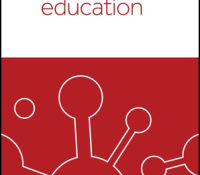eric.ed.gov har udgivet: The article begins with a brief overview of the situation throughout the world regarding problem solving. The activities of the ProMath group are then described, as the purpose of this international research group is to improve mathematics teaching in school. One mathematics teaching method that seems to be functioning in school is the use of open problems (i.e., problem fields). Next we discuss the objectives of the Finnish curriculum that are connected with problem solving. Some examples and research results are taken from a Finnish-Chilean research project that monitors the development of problem-solving skills in third grade pupils. Finally, some ideas on “teacher change” are put forward. It is not possible to change teachers, but only to provide hints for possible change routes: the teachers themselves should… Continue Reading →
Like this:
Like Loading...
eric.ed.gov har udgivet: It is alleged by math teachers and their supporters that math problem solving actually transfers to skills in real or applied problem solving (RAPS). The purpose of this paper is to discuss the issue of math problem solving and the concomitant concept of mental discipline/transfer of learning. The mental discipline theory and evidence to support this theory is broached first, then the relationship between mental discipline and math problem solving is discussed. It is concluded that mathematics should be taught in public schools when there is high interest, high aptitude, or high need for this kind of learning. When math is taught, it should be taught well, integrating math theory as much as possible into the real world that surrounds students. Otherwise, the time spent in public… Continue Reading →
Like this:
Like Loading...
eric.ed.gov har udgivet: The main goal of this study is to find out the effect of the instructional design method on the enhancement of problem solving abilities of students. Teaching sessions were applied to ten students who are in 11th grade, to teach them problem solving strategies which are working backwards, finding pattern, adopting a different point of view, solving a simpler analogous problem, extreme cases, make drawing, intelligent guessing and testing, accounting all possibilities, organizing data, logical reasoning. Our study based on one-on-one (teacher-experimenter and student) design experiments where we conduct teaching sessions with a small group of students to study in depth and detail. We designed sessions to teach high school students, problem-solving strategies in a ten-week long period. Before and after the application of instructional design, 12… Continue Reading →
Like this:
Like Loading...
eric.ed.gov har udgivet: This book reports on a study of the implementation of the 1995 Mathematics Curriculum Framework conducted by the Massachusetts Teachers Association’s Center for Educational Quality and Professional Development (CEQ). It examines whether schools and districts provide students with the curriculum and instruction necessary to succeed on the Massachusetts Comprehensive Assessment System (MCAS) Mathematics Test. This study concludes that in the process of implementing elements of education reform, teachers and principals have been marginalized by the state agency. (KHR) Link til kilde
Like this:
Like Loading...
tandfonline.com har udgivet en rapport under søgningen “Teacher Education Mathematics”: Abstract Formulae display:?Mathematical formulae have been encoded as MathML and are displayed in this HTML version using MathJax in order to improve their display. Uncheck the box to turn MathJax off. This feature requires Javascript. Click on a formula to zoom. Abstract Self-regulated learning (SRL) strategies have gained a great prominence in second language reading comprehension; however, to have a comprehensive picture of their efficacy, this study investigated the significant relationships among SRL components, reading comprehension and reading problem solving. Moreover, it examined the effects of SRL instruction on SRL strategies, reading comprehension, problem solving and the strength of the relationships among these variables. To this end, 183 Iranian English as a foreign language (EFL) learners participated in two phases… Continue Reading →
Like this:
Like Loading...
eric.ed.gov har udgivet: The need for mathematics teachers to incorporate instruction in problem-solving skills into the curriculum is discussed. Results of a study of problem-solving instruction in the classrooms of nine seventh grade teachers are briefly noted. There were significant differences between the teachers in how they planned, organized, and delivered lessons, but there was little difference between regular lessons and problem-solving lessons. Moreover, students showed little improvement in problem solving. A complete description of the study is included. How the teachers taught is described in some detail. Implications are discussed in terms of organizational style, problem-solving content, and other teaching methods. Several figures and tables are supplied. (MNS) Link til kilde
Like this:
Like Loading...
eric.ed.gov har udgivet: In this study, different factors affecting students’ differential equations (DEs) solving abilities were explored at pre university level. To explore main factors affecting students’ differential equations problem solving ability, articles for a 19-year period, from 1996 to 2015, were critically reviewed and analyzed. It was revealed that combination of four factors; “epistemological math problem solving beliefs, belief about usefulness of mathematics, self-regulated learning (SRL) strategies and goal orientations” have great potential to enhance differential equation problem ability. Based on these findings, a conceptual model was developed and presented in this paper to enhance differential equation problem solving ability. This study has provided several important implications for the curriculum designers and teachers to enhance conceptual understanding in differential equation problem solving, particularly in the developing countries.. Link til… Continue Reading →
Like this:
Like Loading...
eric.ed.gov har udgivet: The Likelihood-to-Act (LtA) survey and a mathematics test were used in this study to assess students’ impulsive-analytic disposition in the context of mathematical problem solving. The results obtained from these two instruments were compared to those obtained using two widely-used scales: Need for Cognition (NFC) and Barratt Impulsivity Scale (BIS). The exhibited correlations of the LtA scores with the NFC, BIS, and a math test provide evidence of the criterion validity of the analytic LtA items, and suggests further revision of the impulsive LtA items to improve the overall measurement validity of the LtA scale. Students LtA scores were found to be marginally correlated to their math scores and correlated to their confidence levels in the math items. Link til kilde
Like this:
Like Loading...
eric.ed.gov har udgivet: Primary students solve “oversized” story problems using drawings, equations, and written responses, helping them understand the links between the language of story problems and the numerical representations of matching equations. The activity also includes oral language and reflective writing, thus bringing together a variety of language experiences into mathematics work. During one 30-minute and one 60-minute session, students will: participate in a shared problem-solving activity; collaborate in small groups to develop a problem-solving strategy; use drawings, words, and equations to model solutions to story problems; effectively and clearly explain their problem-solving strategies to other students; and write about and reflect on their problem-solving strategies. The instructional plan, lists of resources, student assessment/reflection activities, and a list of National Council of Teachers of English/International Reading Association (NCTE/IRA) Standards… Continue Reading →
Like this:
Like Loading...
tandfonline.com har udgivet en rapport under søgningen “Teacher Education Mathematics”: ABSTRACT ABSTRACT Context-based learning aims to make learning more meaningful by raising meaningful problems. However, these types of problems often require reflection and thinking processes that are more complex and thus more difficult for students, putting high demands on students’ problem-solving capabilities. In this paper, students’ approaches when solving context-based chemistry problems and effects of systematic scaffolds are analysed based on the Model of Hierarchical Complexity. Most answers were initially assigned to the lowest level of the model; higher levels were reached without scaffolds only by few students and by most students with scaffolds. The results are discussed with regard to practical implications in terms of how teachers could make use of context-based tasks and aligned scaffolds to help students… Continue Reading →
Like this:
Like Loading...

